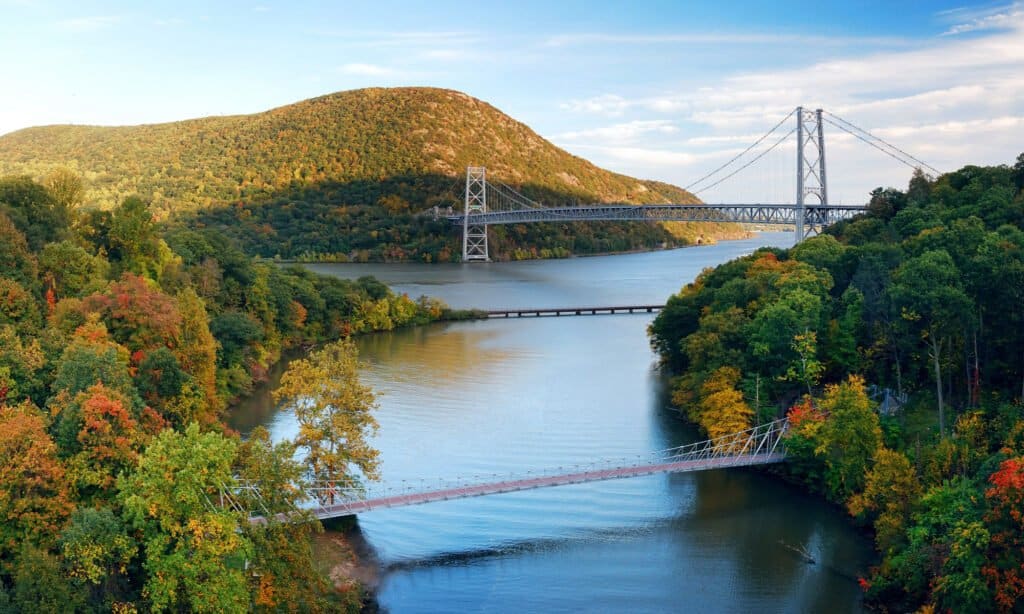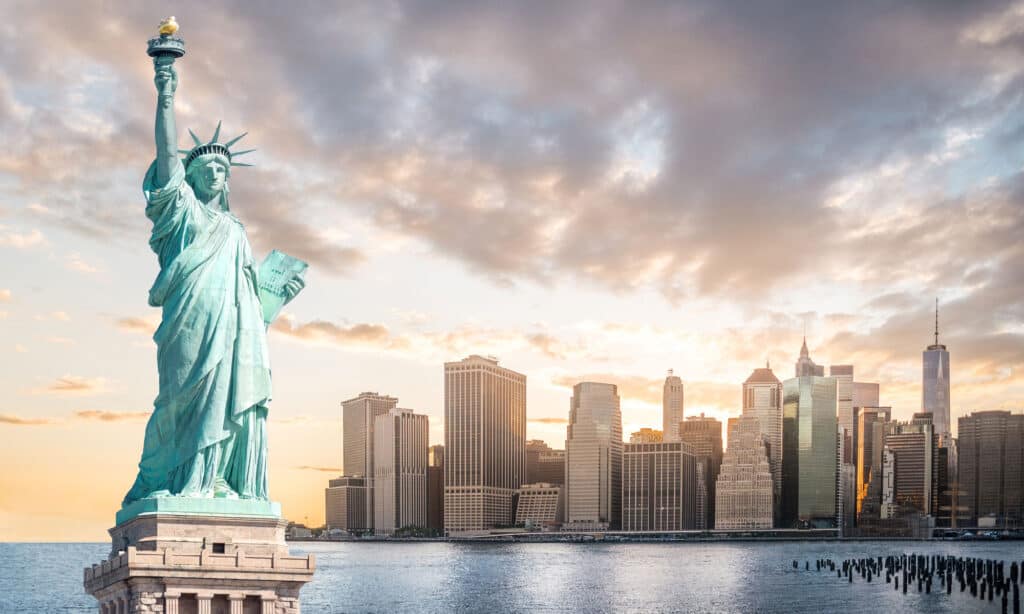
The Hudson River, known as “the river that flows both ways,” runs through the state of New York before emptying into the Atlantic Ocean. This river has tides and salty water, resulting in a bidirectional water flow. Its Mahican name is Muh-he-kun-ne-tuk, and its English name is after Henry Hudson, an Englishman who investigated the river in 1609.
When exploring, Henry Hudson may have wondered where the Hudson River starts. Let’s find out where this river starts!
Where Does The Hudson River Start?

The Hudson River starts in Lake Tear of the Clouds in the Adirondack Mountains in Essex County, Upstate New York.
©Songquan Deng/Shutterstock.com
The Hudson River’s origin is in Lake Tear of the Clouds. This lake is in the Adirondack Mountains in Essex County of upstate New York. Also, the river is 315 miles long and eventually ends in the Atlantic Ocean in New York City. So, the Hudson River starts in Lake Tear of the Clouds and ends in the Atlantic Ocean.
The Course Of The Hudson River
While the Hudson River starts at the highest point of the Adirondack Mountains, the Mohawk River also feeds into it, joining the Hudson at Troy. This tributary connects with the Hudson just before reaching the Hudson River Valley. Then, a dam separates the river into its upper and lower sections in the Hudson River Valley. After this, the river widens and travels until it reaches the Atlantic Ocean. Finally, the Hudson River enters the Atlantic Ocean between Manhattan and the New Jersey Palisades. This area is the New York Harbor at New York Bay and is an arm of the Atlantic Ocean.
The Narrows is a maritime gateway on the Hudson River. As a tidal strait between Staten Island and Brooklyn, the Narrows connects New York Bay’s upper and lower sections. This area is the most important entrance into the New York Harbor.
The widest point of the Hudson River is Haverstraw Bay, between Croton Point and the town of Haverstraw. Croton Point lies southeast, while Haverstraw lies in the northwest. In a beautiful area, it is common to see many boaters and marinas. If this lifestyle interests you, you can explore the Croton Yacht Club, Croton Sailing School, and Haverstraw Marina in Haverstraw Bay.
Navigation On The Hudson River

In the late 1800s, the Hudson River became a federal government waterway.
©Akitzhaber/Shutterstock.com
In the 1800s, authorities opened three canals to link the Hudson River to the Great Lakes, the Delaware River valleys, and the lower St. Lawrence River valleys. The Erie, Delaware and Hudson, and the Champlain are these three canals. This development drove the Hudson River to become a commercial route, with towns sprouting along the river.
In the late 1800s, the Hudson River became a federal government waterway. Between Albany and the Mohawk River, the Hudson River is open to ocean-going ships. In addition, recreational boats and tugboat-barge traffic can navigate this area from May to December.
Businesses also transport cargo like wood pulp, steel, cocoa beans, grain, and scrap metal on the Hudson River. There has also been a range of tunnels and bridges built across the river for passenger traffic. Examples of the major bridges are the following:
- Castleton-on-Hudson
- The Rip Van Winkle
- The Newburgh-Beacon
- The Bear Mountain
- The Tappan Zee
- The George Washington
Major Cities On The Hudson River

The Hudson River flows through Lower Manhattan towards its end destination in the Atlantic Ocean.
©iStock.com/spyarm
The Hudson River flows through New York State and enters New Jersey. On its path, the river forms a political border between the two states because it flows through the Hudson Valley and borders New Jersey’s southern end. Another feature of the Hudson River is that it creates a boundary between counties in the state of New York.
The major cities along the Hudson River are:
- Albany
- Beacon
- Glens Falls
- Hudson
- Jersey City
- Kingston
- Mechanicville
- New York
- Newburgh
- Peekskill
- Poughkeepsie
- Troy
- Yonkers
The Tributaries Of The Hudson River
The Hudson River has a large number of tributaries. Here are several of these tributaries, starting in the north and moving southwards:
- Opalescent Brook
- Cedar River
- Indian River
- Boreas River
- Schroon River
- Sacandaga River
- Mill Creek
- Battenkill River
- Hoosic River
- Mohawk River
- Normans Kill
- Catskill Creek
- Esopus Creek
- Rondout Creek
- Roeliff-Jansen Kill
- Crum Elbow Creek
- Wappingers Creek
- Fishkill Creek
- Moodna Creek
- Croton River
- Pocantico River
- Sparkill Creek
- Wicker’s Creek
- Saw Mill River
How Deep Is The Hudson River?
The Hudson River’s deepest point is known as “World’s End” and reaches a maximum depth of 216 feet. This point is in New York City between Gee’s Point and Constitutional Island.
The Hudson River is the deepest in the United States and is categorized as a fjord. A fjord is a long, narrow stream of water that forms when glaciers melt. Fjords are uncommon in the U.S., but the Wisconsin glacier created the Hudson River, the last glacial episode in North America.
Wildlife Along The Hudson River

Whales are common sights in the Hudson River ending in the Atlantic Ocean.
©iStock.com/kenglye
The Hudson River region has over 200 species of fish, 19 species of rare birds, and over 140 species of rare plants. One of these plants is the Hudson River water nymph, which is native to the region. Other famous residents of the Hudson River include the diamondback terrapin, humpback whales, bald eagles, seahorses, and oysters.
Diamondback terrapins are aquatic turtles living in the Hudson River estuary. Another visitor to the region is the humpback whale. This whale feed on krill and plankton, which have returned to the river after conservation efforts. Bald eagles nearly became extinct in the region but were reintroduced in 2002. Today, their population is thriving. Like the lined seahorse, other seahorses live in the estuary and the river’s shallow water. Native oysters are also found in the river and near the Palisade Boat Club in Hastings-on-Hudson.
You can also check out what lives at the bottom of the Hudson River.
The photo featured at the top of this post is © iStock.com/spyarm
Thank you for reading! Have some feedback for us? Contact the AZ Animals editorial team.







